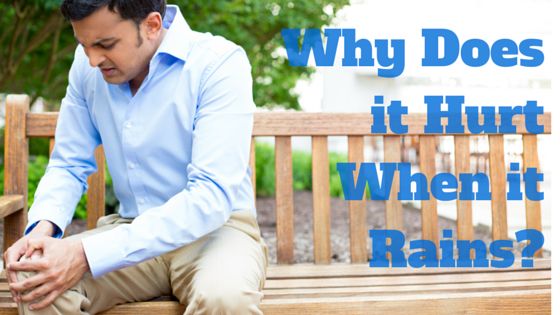Ask the Docs

Why Do My Joints Hurt More When It Rains?
By Dr. Jonathon Chung
One of the most common problems I hear about with patients with chronic pain is that rainy weather seems to make things worse. Is there a real biological reason for this or is this just an old wives tale that has been passed on through time?
Don’t Stop Believing: The Uncontrollable Factor
People have been talking about how they can sense weather patterns in their joints for thousands of years. You’ve probably heard of this phenomenon from your grandmother or another relative whose arthritis pain flared up when it rains. They might say that they feel the rain in their bones.
Hippocrates, the Father of Medicine, was the first to note changes in a person’s illness status due to weather way back in 400 BC. Yet, as long as this idea has been around, studies about this phenomenon have been inconclusive. Some studies show that pain patients can feel a difference, while others say that the weather makes no difference.
It’s hard to study this effect because of the impact that belief systems have on pain. When human beings have a strong enough belief in something, it can drastically affect their perception of the world. This is seen in pain science all the time, and it makes studying pain very challenging and difficult.
Short of locking people in a box and hiding them from weather reports, it’s hard to know how this affects humans with any degree of certainty.
Animal Studies Leaving Clues
While belief systems can impact humans, some of our furry friends have helped leave some clues.
Scientists believe that the pressure in the air (barometric pressure) is what allows people to feel pain when the weather changes. When storms come, the pressure in the atmosphere begins to drop. The theory is that as air pressure drops, it decreases the amount of pressure on your joints leading to the joints and soft tissues to expand and irritate nerve endings causing pain.
In West Palm Beach, we get a ton of thunderstorms so pain patients have the unfortunate opportunity to experience this regularly.
Scientists tested this idea on guinea pigs and rats. They placed animals bred with a pain predisposition into two environments. One group had normal air pressure while the other group had the air pressure lowered artificially.
They found that the low pressure animals showed increased pain behavior compared to the controls.
This is important because you can’t sway or convince an animal that lower pressure is going to make them hurt more. It’s a much closer relationship to cause and effect than can be currently studied in human beings.
So What? Is This Treatable?
So we know that feeling weather changes when you have pain syndromes is at least plausible based on animal models, but why does it happen and is it treatable? The truth is – we still don’t really know what mechanisms cause this type of pain so we have no idea if it’s treatable or preventable.
Based on my experience, I believe that when pain tends to be triggered or aggravated by weather, there’s likely a pain processing problem in the body.
Tissue Damage vs. Pain Perception
The most common conditions associated with weather-related pain are osteoarthritis (wear and tear arthritis, not joints on fire arthritis), headaches, and fibromyalgia. The important thing to note about these 3 conditions is that the pain related to these conditions is NOT dependent on tissue damage. What does that mean?
It means that the level of pain associated with these conditions is not tied to the amount of damage that’s in the body. When you have a sprained ankle, broken bone, torn muscle, or a cut, there is damage done to the tissues that sets off a series of chemical signals meant to trigger a pain response. It’s a very linear relationship.
With joint degeneration, you might feel pain, you might not. With headaches and fibromyalgia, there’s not necessarily any physical damage that’s related to the pain being felt.
It’s not to say that the pain isn’t real, it just means that there’s no obvious source of damage that’s causing the pain. The problem is related to the way your brain processes pain. Your brain has a built in volume control for pain perception. It can turn these signals up in certain situations, and it can turn it down in others. Chronic pain patients have their volume dial on high all the time.
It’s not just a matter of belief. Although that’s an important piece of the puzzle, there are other factors like:
- Brain oxygenation
- Hormones in the blood
- Global inflammation
- Joint movement, especially in the spine
That’s why pain isn’t just a physical phenomenon. I’m sure you’ve been in a situation where you suffered an injury, but you didn’t feel it until much later. This happens frequently after the shock of car accident, the thrill of playing in a championship game, or the necessity of escaping a dangerous situation.
You get stunned, your heart races, adrenaline is surging through the veins, and you don’t notice any pain until hours later when those hormones leave the blood stream.
Pain Perception is Malleable
“I used have headaches every time it rained. Summers in South Florida used to mean daily headaches because of how many storms passed through. After seeing Dr. Chung, I don’t have those terrible headaches anymore — Rona K”
This brings some good news and bad news.
Bad News: It means that for lots of cases, there might not be a treatable lesion that is generating some of the chronic pain problems you’re feeling.
Good News: This also means that your pain levels are malleable and there are different things you can do to turn down the volume of the pain you experience. Things like meditation, exercise, and cognitive therapy can all allow us to change our experience with pain, and get a little bit more control over how we feel. It gives us control over the volume dial.
This is actually one of the primary mechanisms that Atlas Corrections can help people with headaches, fibromyalgia, and arthritis related pain syndromes. We are not fixing or repairing damaged tissue, we are creating an environment for healthy neurological function.
When the structure of the head and neck are disrupted, it decreases 2 things:
- Blood supply in and out of the brain
- Mechanical input into the brain
Both of these factors cause the brain to be more sensitive to pain signals. When the spine moves better and normal blood supply is restored, you can see not only an improvement to someone’s weather related pain, but also an improved resiliency and control over chronic pain syndromes.
***
Did you like this article? Feel free to share it with the people you care about and see if a Complimentary Consultation is the next step to regain their health.
Dr. Chung is a practicing Structural Chiropractor in the West Palm Beach area. He has been published in peer reviewed scientific journals and is a sought after speaker in health and wellness. Follow his blog at http://chiropractorwellington.com/category/keystone-chiropractic-blog/ or find him on twitter at @drjonathanchung.


